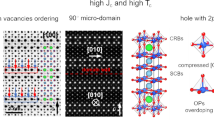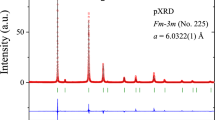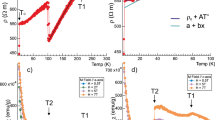Abstract
High-temperature superconductivity has gained renewed attention following recent reports of the onset of superconductivity above 100 K in oxide systems containing copper, alkaline earths and bismuth1 or thallium2–4. The superconducting oxide in the Bi–Sr–Ca–Cu–O system has been identified as Bi2Sr3–xCaxCu2O8, and its structure comprises pairs of CuO2 sheets, interleaved by Ca(Sr), alternating with double bismuth-oxide layers5–7, Hazen et al.8 have identified two new superconducting phases, Tl2Ba2Ca2Cu3O10 (2223) and Tl2Ba2CaCu2O8 (2212), both with tetragonal or pseudotetragonal structures that are probably related to the structure of Bi2Sr3–xCaxCu2O8. Here we present X-ray diffraction data for a single crystal of the 2212 phase, which has an onset temperature of ∼112 K. The crystal structure, based on a body-centred tetragonal cell with a =3.8550(6) Å and c = 29.318(4) Å (space group I4/mmm), is essentially the same as that of Bi2Sr3–xCaxCu2O8 and comprises double copper-oxygen sheets alternating with double thallium-oxygen layers. There are Ca2+ cations between adjacent Cu–O sheets and Ba2+ cations between the Cu–O and Tl–O layers. The copper–oxygen chains present in YBa2Cu3O7 are absent in Tl2Ba2CaCu2O8.
This is a preview of subscription content, access via your institution
Access options
Subscribe to this journal
Receive 51 print issues and online access
$199.00 per year
only $3.90 per issue
Buy this article
- Purchase on Springer Link
- Instant access to full article PDF
Prices may be subject to local taxes which are calculated during checkout
Similar content being viewed by others
References
Maeda, M., Tanaka, Y., Fukutomi, M. & Asano, T. Jap. J. appl. Phys. 27, L209–L210 (1988).
Sheng, Z. Z. & Hermann, A. M. Nature 332, 55–58 (1988).
Sheng, Z. Z. & Hermann, A. M. Nature 332, 138–139 (1988).
Hazen, R. M. et al. Phys. Rev. Lett. (in the press).
Subramanian, M. A. et al. Science 239, 1015–1017 (1988).
Sunshine, S. A. et al. Phys. Rev. Lett. (submitted).
Tarascon, J. M. et al. Phys. Rev. B (submitted).
Hazen, R. M. et al. Phys. Rev. Lett. (submitted).
Shannon, R. D. Acta crystallogr. A32, 751–767 (1976).
Fueki, K. et al. in Chemistry of High-Temperature Superconductors (eds Nelson, D. L., Whittingham, M. S. & George, T. F.) 38–48 (American Chemical Society, Washington, 1987).
Subramanian, M. A. et al. Science (in the press).
Torardi, C. C. et al. in Chemistry of High-Temperature Superconductors (eds Nelson, A. L., Whittingham, M. S. & George, T. F.) 152–163 (American Chemical Society, Washington, 1987).
Torardi, C. C. et al. Nature (submitted).
Author information
Authors and Affiliations
Rights and permissions
About this article
Cite this article
Subramanian, M., Calabrese, J., Torardi, C. et al. Crystal structure of the high-temperature superconductor TI2Ba2CaCu2O8. Nature 332, 420–422 (1988). https://doi.org/10.1038/332420a0
Received:
Accepted:
Issue Date:
DOI: https://doi.org/10.1038/332420a0
This article is cited by
-
Paramagnons and high-temperature superconductivity in a model family of cuprates
Nature Communications (2022)
-
Superconductive hydrogen-rich compounds under high pressure
Applied Physics A (2021)
-
Effect of Oxygen Treatment on the Structural and Electrical Properties of Tl0.85Cd0.15Sr2CuO5−δ , Tl0.85Cd0.15Sr2Ca2Cu2 O 7−δ and Tl0.85Cd0.15Sr3Ca2Cu3 O 9−δ Superconductors
Journal of Superconductivity and Novel Magnetism (2017)
-
Investigation of the relationship betweenT c and the Coulomb interaction of copper cations from the neighboring CuO2 layers
Journal of Structural Chemistry (1999)
Comments
By submitting a comment you agree to abide by our Terms and Community Guidelines. If you find something abusive or that does not comply with our terms or guidelines please flag it as inappropriate.



